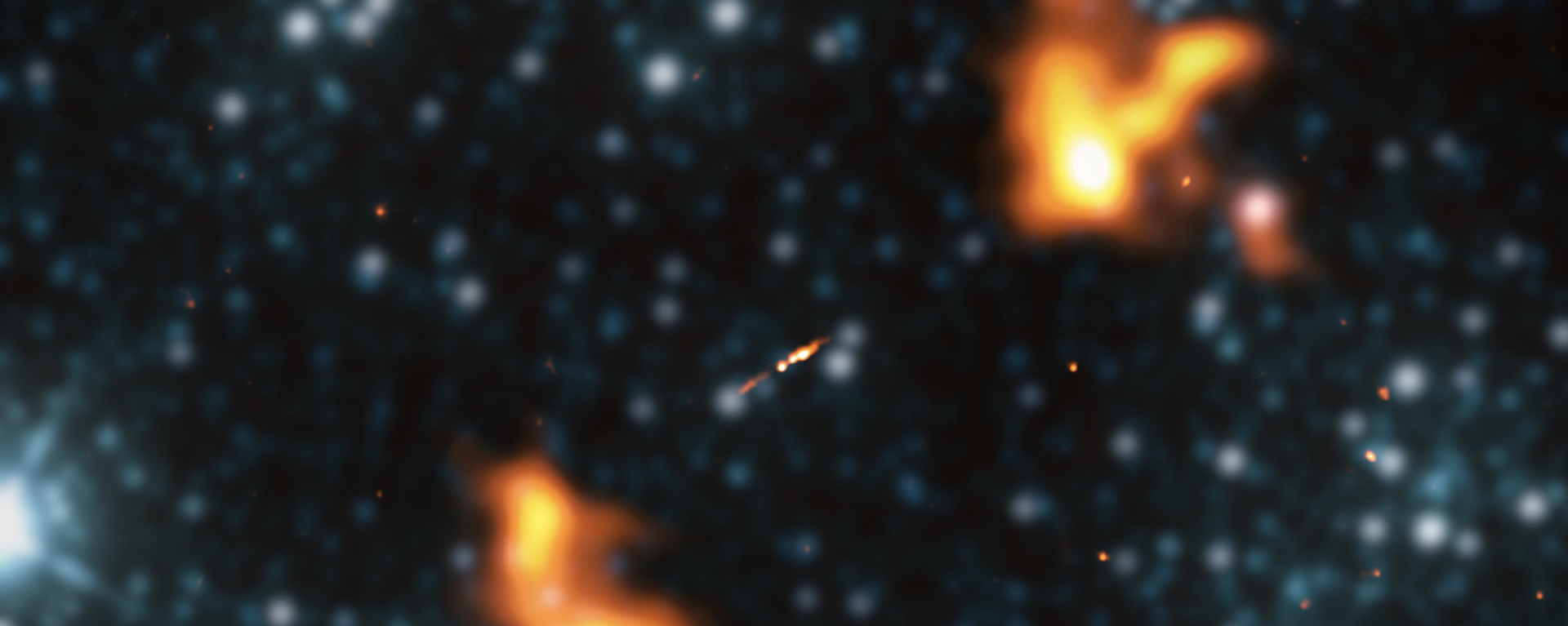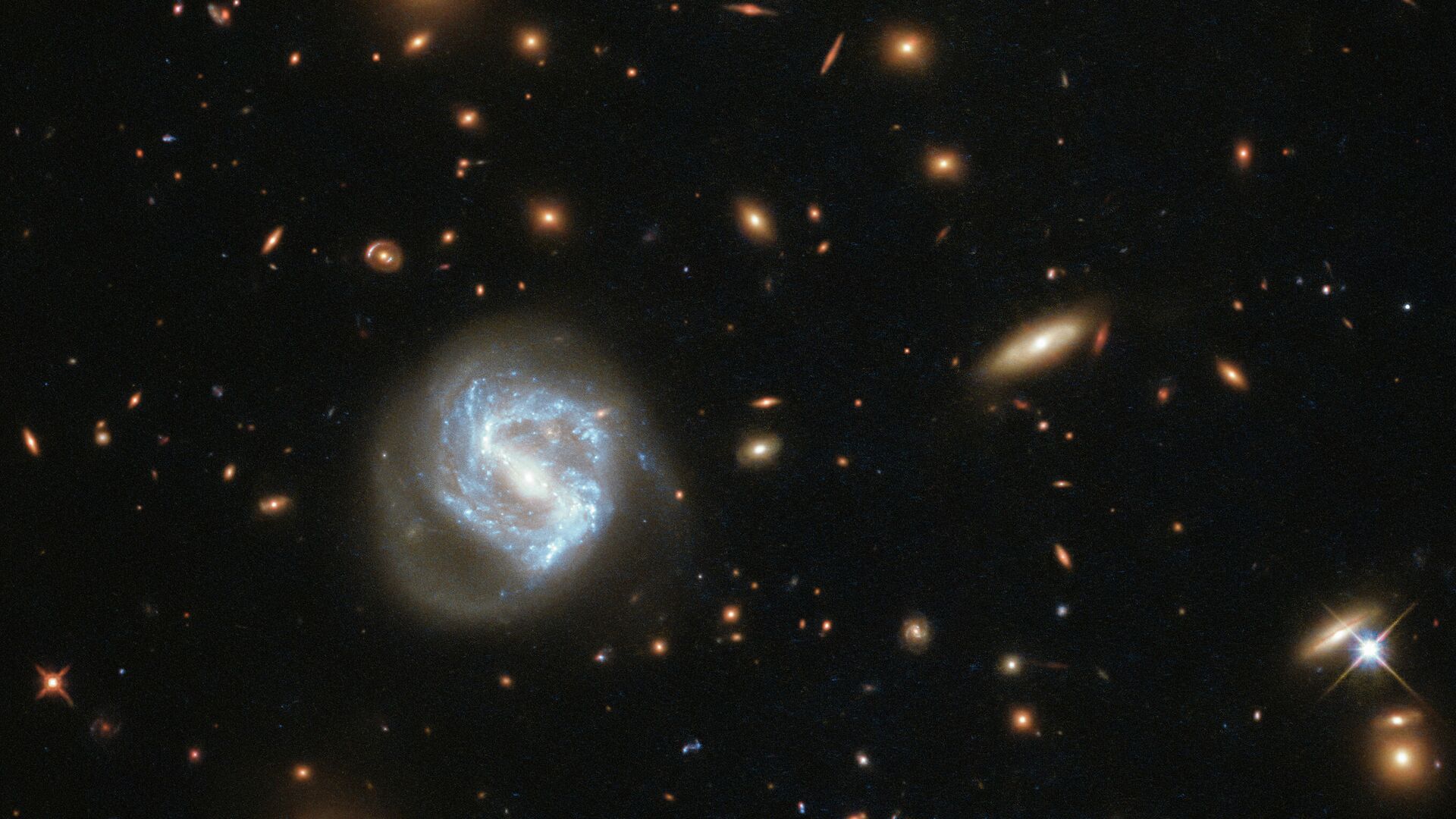https://sputnikglobe.com/20220315/scientists-replicate-galaxy-cluster-plasma-with-almost-200-lasers-to-solve-mystery-of-hot-gas-1093906131.html
Scientists Replicate Galaxy Cluster Plasma With Almost 200 Lasers to Solve Mystery of Hot Gas
Scientists Replicate Galaxy Cluster Plasma With Almost 200 Lasers to Solve Mystery of Hot Gas
Sputnik International
Scientists have long known that the hydrogen gas in galaxy clusters is extremely hot, at roughly 10 million degrees Kelvin, or about the same temperature as... 15.03.2022, Sputnik International
2022-03-15T23:33+0000
2022-03-15T23:33+0000
2023-04-12T16:57+0000
science & tech
laser
laser system
galaxy
experiment
space
https://cdn1.img.sputnikglobe.com/img/07e6/03/0f/1093907754_0:519:2719:2048_1920x0_80_0_0_b6b38341f9f60bfaab59fe24ce578a47.jpg
Researchers from the University of Chicago, the University of Oxford, and the University of Rochester have collaborated to use the National Ignition Facility in Livermore, California, to mimic the hot gas seen in massive galaxy clusters - an experiment that could lead to the solution of an astronomical mystery.Galaxies rarely exist in isolation. Instead, gravity draws hundreds to thousands of them together, generating huge clusters that are the known universe's largest objects. The extremely high temperature of gas among them should have cooled over the course of the age of the universe, according to standard physics. But this has not happened, and nobody yet knows why. As hydrogen atoms cannot exist at such temperatures, the gas is actually a plasma made up of the building blocks of atoms, including protons and electrons.The difficulty for researchers in attempting to solve the puzzle of galaxy cluster gas temperature is the extreme difficulty of replicating these intensely hot and magnetic circumstances in usual conditions.In new research published in the journal Science last week, scientists revealed that they were able to produce these extreme conditions, albeit for only a fraction of a second and in a volume around the size of a penny.Researchers focused 196 lasers on a single small target, resulting in a white-hot plasma with powerful magnetic fields that lasts just a few billionths of a second. This gave them ample time to see that, instead of a uniform temperature, the plasma had relatively hot and cold patches. This is said to be consistent with one of the main hypotheses for how heat is trapped inside of galaxy clusters. Heat would normally be easily diffused as electrons collide with one another. The tangled magnetic fields inside the plasma, however, might impact these electrons, causing them to spiral in the direction of magnetic fields, preventing them from dispersing and distributing their energy equally.Researchers discovered that in the experiment energy conduction was inhibited by overt a factor of 100.Another co-author of the paper, University of Rochester Prof. Petros Tzeferacos described the experiment as "indeed an astonishing result." The simulations were carried out using the FLASH computer software, which was created at the University of Chicago and is now based at Tzeferacos' Flash Center for Computational Science at the University of Rochester. According to SciTechDaily, scientists may use the software to model laser experiments in great detail before they are carried out, ensuring that they get usable results. This is crucial, as scientists only get a few shots at the facility, and retakes are next to impossible if something goes wrong. Because the experiment conditions last barely nanoseconds, researchers must ensure that the measurements they require are taken at precisely the proper time. This means that everything must be meticulously planned out ahead of time.Researchers admit, however, that are still several unanswered concerns about the physics of galaxy clusters. Though the hot and cold regions provide strong evidence for the influence of magnetic fields on the cooling of hot gas in galaxy clusters, further research is needed. Later this year, the group will conduct its next batch of experiments at NIF. For the time being, they are said to be content with having shed light on why the gas in galaxy clusters is still burning billions of years later.Let's stay in touch no matter what! Follow our Telegram channel to get all the latest news: https://t.me/sputniknewsus
https://sputnikglobe.com/20220219/discovery-of-largest-galaxy-yet-observed-baffles-astronomers--1093187542.html
Sputnik International
feedback@sputniknews.com
+74956456601
MIA „Rossiya Segodnya“
2022
News
en_EN
Sputnik International
feedback@sputniknews.com
+74956456601
MIA „Rossiya Segodnya“
Sputnik International
feedback@sputniknews.com
+74956456601
MIA „Rossiya Segodnya“
science & tech, laser, laser system, galaxy, experiment, space
science & tech, laser, laser system, galaxy, experiment, space
Scientists Replicate Galaxy Cluster Plasma With Almost 200 Lasers to Solve Mystery of Hot Gas
23:33 GMT 15.03.2022 (Updated: 16:57 GMT 12.04.2023) Kirill Kurevlev
Managing Editor
Scientists have long known that the hydrogen gas in galaxy clusters is extremely hot, at roughly 10 million degrees Kelvin, or about the same temperature as the sun's core. But there is still no clear explanation for why or how the gas stays so hot for such long periods.
Researchers from the University of Chicago, the University of Oxford, and the University of Rochester have collaborated to use the National Ignition Facility in Livermore, California, to mimic the hot gas seen in massive galaxy clusters - an experiment that could lead to the solution of an astronomical mystery.
Galaxies rarely exist in isolation. Instead, gravity draws hundreds to thousands of them together, generating huge clusters that are the known universe's largest objects. The extremely high temperature of gas among them should have cooled over the course of the age of the universe, according to standard physics. But this has not happened, and nobody yet knows why.
As hydrogen atoms cannot exist at such temperatures, the gas is actually a plasma made up of the building blocks of atoms, including protons and electrons.
The difficulty for researchers in attempting to solve the puzzle of galaxy cluster gas temperature is the extreme difficulty of replicating these intensely hot and magnetic circumstances in usual conditions.
In new research published in the
journal Science last week, scientists revealed that they were able to produce these extreme conditions, albeit for only a fraction of a second and in a volume around the size of a penny.
“The experiments conducted at the NIF are literally out of this world,” stated Jena Meinecke, the paper's first author, per the SciTechDaily report.
Researchers focused 196 lasers on a single small target, resulting in a white-hot plasma with powerful magnetic fields that lasts just a few billionths of a second. This gave them ample time to see that, instead of a uniform temperature, the plasma had relatively hot and cold patches.
This is said to be consistent with one of the main hypotheses for how heat is trapped inside of galaxy clusters. Heat would normally be easily diffused as electrons collide with one another. The tangled magnetic fields inside the plasma, however, might impact these electrons, causing them to spiral in the direction of magnetic fields, preventing them from dispersing and distributing their energy equally.
Researchers discovered that in the experiment energy conduction was inhibited by overt a factor of 100.
"This is an incredibly exciting result because we’ve been able to show that what astrophysicists have proposed is on the right track," Prof. Emeritus Don Lamb, the Robert A. Millikan Distinguished Service Professor Emeritus in Astronomy and Astrophysics and study co-author, said.

19 February 2022, 22:14 GMT
Another co-author of the paper, University of Rochester Prof. Petros Tzeferacos described the experiment as "indeed an astonishing result."
"The simulations were key to untangling the physics at play in the turbulent, magnetized plasma, but the level of thermal transport suppression was beyond what we expected," he said.
The simulations were carried out using the FLASH computer software, which was created at the University of Chicago and is now based at Tzeferacos' Flash Center for Computational Science at the University of Rochester.
According to SciTechDaily, scientists may use the software to model laser experiments in great detail before they are carried out, ensuring that they get usable results. This is crucial, as scientists only get a few shots at the facility, and retakes are next to impossible if something goes wrong.
Because the experiment
conditions last barely nanoseconds, researchers must ensure that the measurements they require are taken at precisely the proper time. This means that everything must be meticulously planned out ahead of time.
"It’s a challenge when you’re at the very extremes of what can be done, but that’s where the frontier is," Lamb said, according to the publication.
Researchers admit, however, that are still several unanswered concerns about the physics of galaxy clusters. Though the hot and cold regions provide strong evidence for the influence of magnetic fields on the cooling of hot gas in galaxy clusters, further research is needed. Later this year, the group will conduct its next batch of experiments at NIF.
For the time being, they are
said to be content with having shed light on why the gas in galaxy clusters is still burning billions of years later.
Let's stay in touch no matter what! Follow our Telegram channel to get all the latest news: https://t.me/sputniknewsus 

